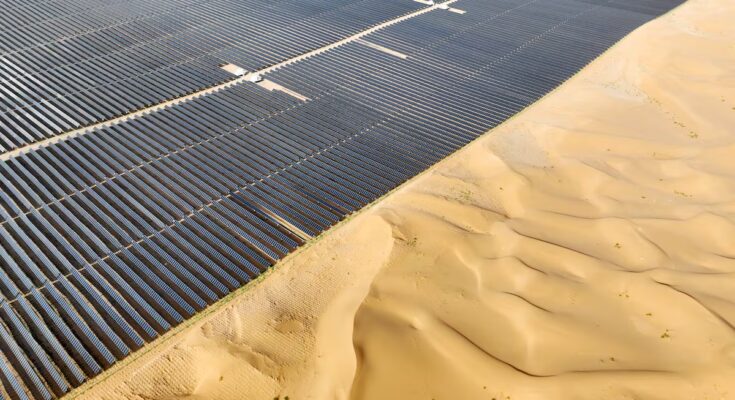On the edge of the Tengger Desert in northern China, whistling winds whip through the blades of an army of wind turbines, as the sun beats down on a sea of solar panels. From that remote landscape of light and sand, in the autonomous region of Ningxia, an electric highway starts which crosses mountains, plateaus and valleys until it reaches Hengyang, in the industrial heart of Hunan province, in the south. Along 1,616 kilometers of steel cables and watchtowers travels part of the electrical flow that keeps the country switched on: the very high voltage infrastructures (very high voltage in English UHV) with which China seeks to protect its grid from blackouts and to redesign its energy map in the midst of the race towards the ecological transition.
“Those towers have been there since last year,” says a resident of Quanhu, 36 kilometers from Hengyang, from the entrance of her house. Her husband works the land and watches in surprise. They live near a gas station among small hills. Nearby stands a transmission tower, one of many that outlined the horizon on the way to that place. He knows that there is a receiver nearby that generates electricity, but he doesn’t understand what the journalist means when she asks about “renewable energy”.
The Ningxia-Hunan UHV line is one of the most ambitious electricity networks of the Asian giant. Designed to transmit direct current at ±800 kilovolts, it has a capacity of 8,000 megawatts and can send more than 36,000 gigawatt hours (GWh) of electricity per year, enough to supply about 10 million homes, according to data from State Grid (the state operator responsible for the national electricity grid) cited by the Xinhua agency.
The electricity travels through five regions (Ningxia, Gansu, Shaanxi, Chongqing and Hubei) before reaching its destination with a loss of less than 3% per 1,000 kilometres, compared to the 6% or 7% that would disappear in a conventional grid. Inaugurated this year and in full operation since August, it is also the first line of its kind designed to transport predominantly green energy. It is powered by systems with a total power of 17.6 GW, of which 9 GW come from photovoltaic and 4 GW from wind.
“Green technology drives energy conversion and environmental awareness builds the future,” reads a sign outside one of the buildings of the Hengyang receiving station, where EL PAÍS recently visited.
China is carrying out the energy transition at a speed that exceeds its own forecasts: in 2024 it had already reached the wind and solar capacity planned for 2030, with over 1,630 GW installed, and in April clean energy exceeded 25% of the national generation share for the first time. President Xi Jinping announced the new goals for 2035 during the UN climate summit in September: 3,600 GW of installed capacity and a share of electricity generated from renewable sources above 30%.
But the challenge is that much of this clean energy is produced in regions that generate far more than they can consume, in the vast deserts and plateaus of the north and west of the country, sparsely populated and far from the large urban and industrial centers, concentrated along the east coast.
To connect them, China has chosen to create a transmission system based on UHV networks that allows the electricity flow to be reorganized based on demand. This cross-regional shipping capability, say researchers Yubao Wang, Junjie Zhen and Huiyuan Pan in an article published in the journal Sustainabilityoptimizes the use of renewable sources and increases the energy efficiency of companies, reducing dependence on the most polluting local sources and improving coordination between the different networks.
Ms. Hu, 55, ran a restaurant in Hengyang. Recall that around 2005 there were, on average, three blackouts per week. “It was almost always because the energy limit was exceeded,” he explains. He insists that little by little “things have changed” and assures that in the last 10 years “there have been no electrical problems”. While he welcomes China’s ecological progress, he believes there is a “lack of knowledge” about the health effects of living near transmission towers and exposure to electromagnetic fields.
The push for UHV lines began in 2009, when China became a driver of investment and employment after the global financial crisis. After the Fukushima nuclear accident in 2011, the government further tightened its bet; He stopped the construction of reactors near cities and prioritized electric transmission from remote areas.
Over the past five years, the total length of its UHV lines has grown from 18,000 miles to more than 40,000, according to the most recent data from the National Energy Administration. The country currently has 45 UHV lines (one alternating current of ±1,100 kilovolts, 21 of 1,000 kilovolts and 23 direct current of ±800 kilovolts). Beijing expects that, by the end of 2025, west-east transmission capacity will exceed 340 GW, up 25% from 2020, and enough to supply around 230 million Chinese homes.
By comparison, in Europe, the most powerful electricity links (such as the Viking Link between the UK and Denmark or the Nord Link between Germany and Norway) operate at ±500-525 kilovolts and can carry around 1,400 megawatts.
Although the National Energy Administration has prioritized its expansion, reality moves at a different pace. Planning and building these lines takes time and “not even China can develop that fast,” David Fishman, a Shanghai-based energy analyst, said in a text exchange.
Unused energy
In the first half of 2025, the share of unused solar energy increased from 3.9% to 6.6% on an annual basis, and in the case of wind it went from 3% to 5.9%, also because the grid was not able to transport all the production.
China has a voracious appetite for electricity, with a growth rate of 7% per year. The International Energy Organization (IEO) estimates that one in ten cars on the roads is electric; According to the OIE, in 2024, of the 17 million electric vehicles purchased worldwide, 11 million were purchased in China. Furthermore, the fully electric operation of over 48,000 kilometers of high-speed railway lines and the progressive replacement of fossil fuels in various sectors, such as the steel industry, have brought consumption to unprecedented levels.
This gigantic demand causes the country to remain heavily dependent on coal. It’s the other side of the coin: Even though China expects to reach peak carbon dioxide (CO₂) emissions by the end of this decade, it is the planet’s largest emitter in absolute terms – not per capita – and is responsible for 30% of greenhouse gases and 90% of CO₂ emissions growth since 2015, according to Carbon Briefmedia specialized in the sector.
Fishman stresses that China “needs” all the renewable energy it generates “to come online” to limit emissions growth. “This is why UHV lines are more important today than ever,” he emphasizes. China’s CO₂ emissions fell 1.6% year-on-year in the first quarter of 2025 and 1% over the past 12 months. It is the first time that a reduction is directly linked to the increase in renewable energy capacity and without a slowdown in energy demand, according to a study published in May by Carbon Brief.



